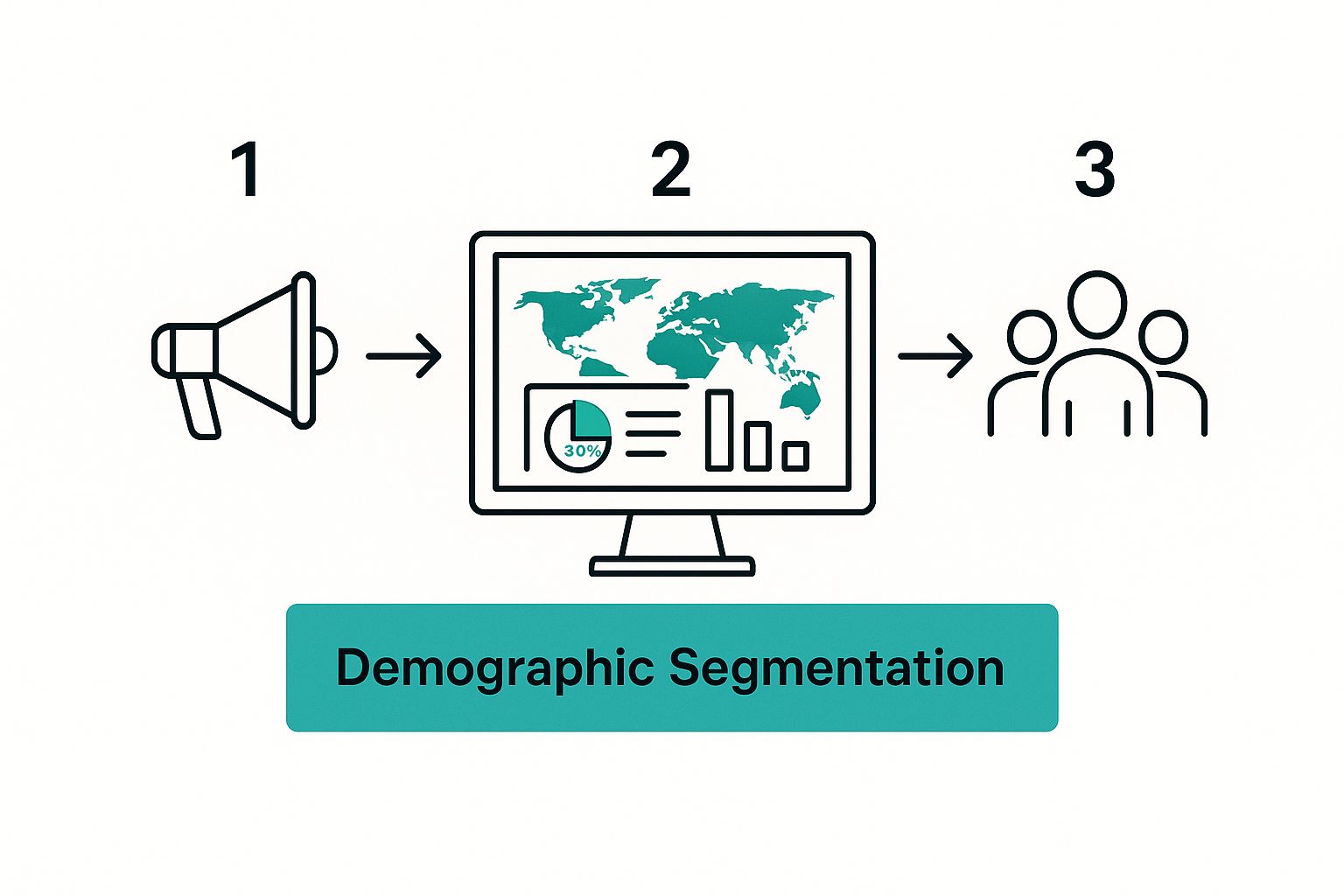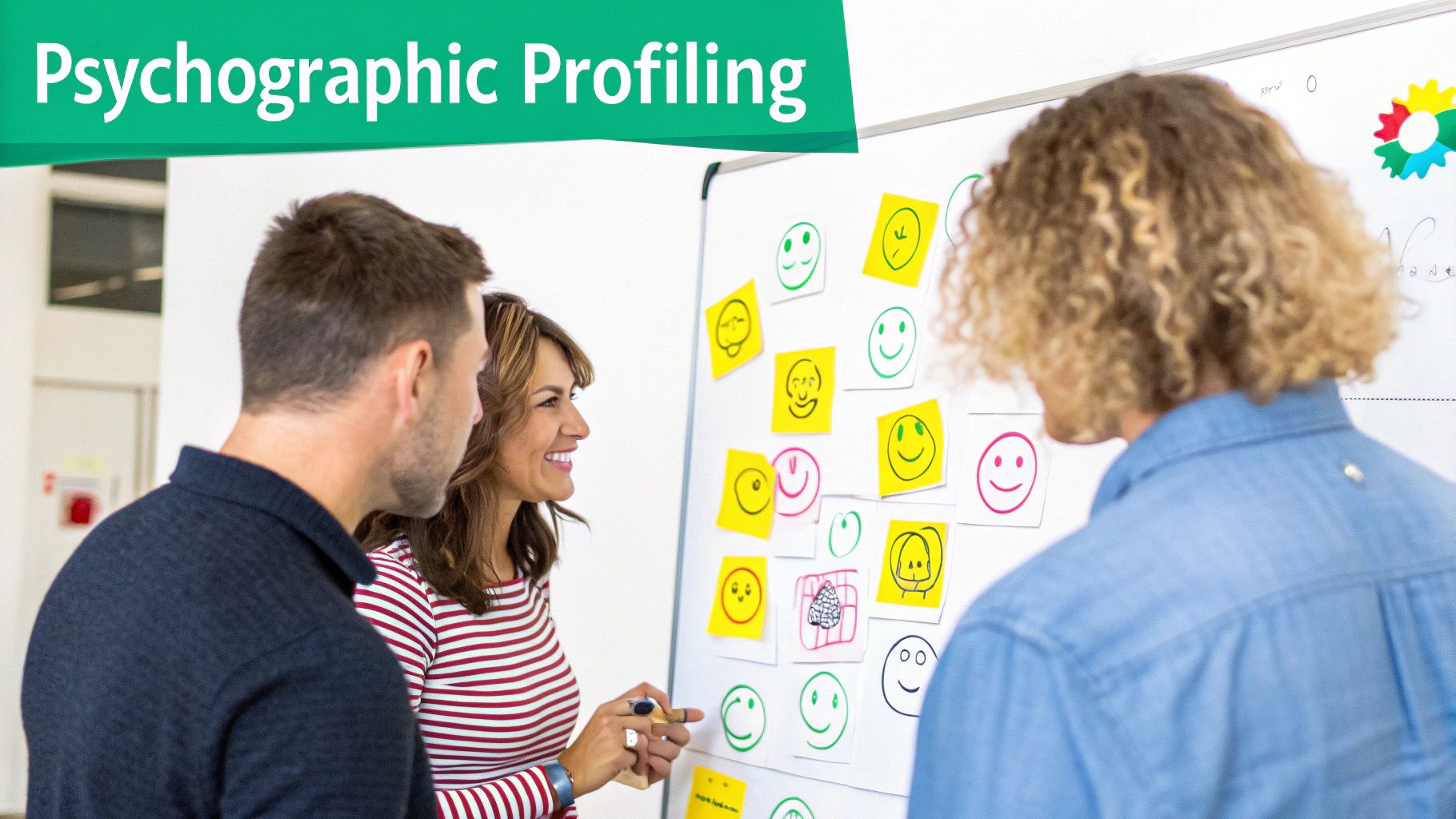How to Identify Your Target Audience: Easy Tips & Strategies
Figuring out your target audience is all about zeroing in on the specific people who will get the most value out of what you offer. It’s about ditching the broad assumptions and digging into the data to really understand what they need, what keeps them up at night, and what gets them excited. Honestly, this is the bedrock of any marketing strategy that actually works.
Why Generic Customer Profiles Don’t Work
Let’s be real for a second: vague ideas about who your audience is will kill your marketing before it even gets off the ground. So many businesses fall into the trap of creating uselessly broad profiles like "millennial professionals" or "small business owners." That’s like trying to hit a bullseye with a shotgun.
This kind of approach just leads to watered-down messaging that tries to speak to everyone but ends up connecting with no one.
The real wins come from a deep, nuanced understanding of who needs you the most. It's not about guessing demographics; it's about starting with a solid hypothesis based on the core problem you solve.
Starting with Your Core Value
Before you can find your people, you have to be crystal clear on what problem you actually solve for them. Take your product's features and translate them into real-world benefits that hit on specific pain points.
For instance, a project management tool doesn't just "organize tasks"—it slashes the stress for overwhelmed team leaders juggling a dozen deadlines. See the difference? That subtle shift changes the conversation from what you sell to what you solve.
This benefit-first thinking is how you build your foundational hypothesis. Who feels this specific pain most intensely?
- Are they in a certain industry?
- Do they have a specific job title?
- What are they using right now that just isn't cutting it?
Answering these questions is your first real step away from generic profiles. It gives you an initial audience segment you can start to research and actually validate.
From here, you can start looking at the competitive landscape to see who’s being ignored or misunderstood. This isn't just about finding any customers; it's about finding the right customers—the ones whose problems you are perfectly built to solve. That’s what sets you up for marketing that feels focused and, more importantly, gets results.
Gathering Meaningful Audience Data
 Once you have a decent hypothesis about who your audience is, it's time to start the real investigation. Forget casting a wide net and hoping for the best. The goal now is to gather focused, actionable intelligence that either confirms or challenges your initial assumptions.
Once you have a decent hypothesis about who your audience is, it's time to start the real investigation. Forget casting a wide net and hoping for the best. The goal now is to gather focused, actionable intelligence that either confirms or challenges your initial assumptions.
The best way to do this is by mixing a few different methods. This gives you a much richer, more reliable picture of your potential customers, ensuring you see the whole story, not just one piece of it.
Tap into What You Already Have
If you’re already in business, your best data is probably right under your nose. Your existing customer database is an absolute goldmine. Dig in and look for patterns in demographics, buying habits, and even common support tickets. This will tell you a ton about who already gets value from your product.
Your website analytics are another fantastic resource. Check out which blog posts get the most traffic, what search terms people are using to find you, and how they move through your site. These breadcrumbs reveal their biggest interests and pain points.
Your current customers and website visitors offer the most authentic look at who finds value in what you offer. Analyzing this group first is the most efficient way to begin identifying your broader target audience.
Proactive Ways to Collect Data
Looking beyond your own assets, it's time to get proactive. Two of the most powerful ways to gather fresh information are through direct surveys and social listening.
Craft Insightful Surveys: Put together short, focused surveys for your email list or website visitors. Steer clear of just multiple-choice and ask open-ended questions like, "What's the biggest challenge you're facing with [your area of expertise]?" or "What other tools have you tried to solve [problem]?" These questions dig up the deeper motivations.
Leverage Social Listening: Tools like Intently are perfect for monitoring conversations happening on platforms like Reddit and LinkedIn. You can track keywords related to your industry to see what real people are discussing, complaining about, and asking for. This uncovers the exact language and frustrations of your potential audience in their natural habitat—a critical step for effective B2B lead generation. To see how this fits into a bigger picture, check out this beginner’s guide to B2B lead generation.
Turning Raw Data into Actionable Insights
Once you've collected a pile of audience data, the real work begins. Raw information from surveys, analytics, and social listening is just noise until you start connecting the dots. This is where you transform scattered data points into a powerful, unified profile of your ideal customer.
The best way to start is by sorting your data into distinct categories. Think of it as organizing the chaos into three main buckets: demographics, psychographics, and behaviors. This helps you see who your audience really is on multiple levels.
Segmenting Your Audience Data
First, tackle the foundational demographic data. This is the easy stuff: age, gender, location, and job title. This information gives you a high-level snapshot of who you're talking to. For example, finding out 75% of your engaged users are project managers in North America immediately sharpens your focus.
Next, you dive into psychographics—the why behind their actions. This layer gets into their values, interests, pain points, and motivations. A project manager might be driven by career advancement, value efficiency above all else, and get frustrated by clunky software. This is where you truly start to understand what makes them tick.
Finally, you need to analyze their behavioral patterns. This covers how they actually interact with your brand or the broader industry.
- Purchase History: Are they snapping up premium products, or do they always wait for a discount?
- Content Consumption: Which blog posts or social media updates get the most engagement from them?
- Online Habits: Do they hang out in specific Reddit communities or LinkedIn groups?
This infographic gives a great visual starting point for how demographics can inform your segmentation.

Visualizing data this way helps you pinpoint geographic hotspots and key demographic concentrations for your marketing.
Identifying Your Most Valuable Segments
With your data all sorted, you can finally pinpoint your most valuable audience segments. These are the folks who not only show interest but also have the motivation and means to actually become customers. You do this by combining your segments to create a much richer picture. For example: "Project managers (demographic) aged 30-45 in the tech industry who value efficiency (psychographic) and actively engage with content about productivity tools (behavioral)."
The goal is to move beyond broad descriptions. A truly actionable insight combines who they are, what they believe, and how they act into a single, cohesive narrative. This clarity is what transforms your marketing from generic to magnetic.
It also helps to understand the bigger picture of global digital trends. As of early 2025, there were 5.56 billion internet users worldwide, with a staggering 5.24 billion active on social media. Knowing that internet usage hits 99% in regions like Northern Europe helps you prioritize markets with high digital connectivity. You can explore more of these global digital population statistics on Statista.com. This kind of data is perfect for validating where your audience is most likely spending their time online.
Bringing Your Audience to Life with Personas

Let's be honest, abstract data and spreadsheets don't exactly spark marketing genius. What does? Relatable stories about the people you're trying to help. This is where you get to turn all those audience insights into detailed, practical customer personas.
A good persona is so much more than a list of traits. It’s a semi-fictional character that represents your ideal customer, giving them a name, a face, and a story.
This character gives your entire team—from marketing to product development—a clear, unified picture of who they’re serving. It helps make every decision genuinely customer-focused. Suddenly, you're not just marketing to a vague "segment"; you're solving real problems for "Creative Director Chloe."
Crafting a Compelling Persona
To build a persona that feels real, you need to pull together all the demographic, psychographic, and behavioral data you’ve collected. The goal is to weave a narrative that feels like you're describing an actual person. Give them a name, a job title, and a bit of a backstory.
What are their biggest professional headaches? What gets them motivated to start their day? Answering questions like these is what breathes life into the data.
- Goals: What are they trying to accomplish in their job or personal life? For instance, Chloe wants to streamline her team’s creative workflow to cut down on burnout.
- Pain Points: What specific roadblocks are keeping them from hitting those goals? Chloe is constantly battling disorganized feedback loops and slipping deadlines.
- Motivations: What's the underlying driver behind their actions? She’s driven by a desire to produce award-winning creative work and earn industry recognition.
A well-crafted persona is your team's north star. It grounds your strategy and serves as a constant reminder that behind every data point is a person with real needs, challenges, and goals.
An effective persona is specific enough to actually guide decisions. Instead of saying they "want better tools," a strong persona clarifies that they "need a project management tool with a dead-simple visual interface for client approvals." That level of detail is what helps you create truly targeted content and product features.
To help you get started, we've put together a template that breaks down the key components of a comprehensive customer persona. This structure will help you organize your research and build a character that your whole team can rally behind.
Customer Persona Development Template
| Component | Description | Example |
|---|---|---|
| Name & Photo | A realistic name and stock photo to make the persona relatable. | Creative Director Chloe |
| Demographics | Basic information like age, location, and education. | 34, lives in Austin, TX, BFA in Graphic Design |
| Role & Responsibilities | Job title, seniority level, and key duties. | Manages a team of 8 designers, oversees all creative output. |
| Goals | Primary professional and personal objectives. | Improve team efficiency, win a design award. |
| Pain Points | Major challenges and frustrations they face. | Inefficient client feedback process, tool overload. |
| Motivations | The underlying "why" behind their goals and actions. | Recognition from peers, creating impactful work. |
| Communication Channels | Where they get information and spend their time online. | LinkedIn, design blogs (e.g., AIGA), industry podcasts. |
By filling out a template like this for each of your key audience segments, you create a powerful reference tool that keeps everyone aligned on who you're serving and why it matters.
This human-centered approach is also the foundation of modern marketing. To take this a step further, our complete guide to AI lead generation tools explains how technology can help you find and engage these ideal customers where they're most active. When you combine rich, detailed personas with smart outreach, your marketing becomes far more effective.
Testing and Refining Your Audience Assumptions
Let's be honest: building an audience persona is never really done. Those detailed profiles you’ve put together are a fantastic starting point, but at the end of the day, they're just well-informed guesses. Now it's time to see if they hold up in the real world.
This is the phase that separates brands that thrive from those that just guess. It’s all about creating a continuous feedback loop—where fresh data helps you make smarter tweaks—to keep your marketing sharp.
Launching Small Scale Tests
One of the best ways to validate your audience segments is to run small, targeted ad campaigns. You don’t need a massive budget for this. The goal is simply to see how your personas react to messaging created just for them.
Platforms like Facebook are perfect for this because of their incredibly detailed targeting options. With over 3.06 billion monthly active users, it’s a huge sandbox to test your assumptions against actual people. A big chunk of that user base is aged 25-34, giving you plenty of data to work with. You can find more details about these social media demographics on SproutSocial.com.
Try running a couple of different ad variations aimed at one of your key personas. Does "Creative Director Chloe" click on the ad that talks about team efficiency, or the one that highlights award-winning design? The results will give you hard evidence of what truly motivates her.
Key Takeaway: Treat every single campaign like a micro-experiment. The data you gather—click-through rates, engagement, conversions—is direct feedback on how well you actually understand your audience.
Gathering Direct Feedback
While ads give you numbers, you also need the stories behind them. Qualitative feedback is just as important. Try reaching out to a handful of people who are a perfect match for your persona profiles and just ask for a quick chat. A small incentive, like a gift card, usually does the trick.
These conversations let you dig so much deeper:
- What are their biggest daily challenges and goals?
- What specific words and phrases do they use to describe their problems?
- How do they react when you pitch your value proposition?
This kind of direct feedback is gold for refining your messaging so it actually connects with people. In fact, continuously tuning into these conversations is a key part of good brand management, which is why we put together our guide on social media reputation monitoring.
This ongoing cycle of testing, listening, and refining is how you truly master identifying your target audience.
Still Have Questions About Finding Your Audience?
Even with a clear roadmap, a few common questions always seem to surface when you're zeroing in on an audience. Let's walk through some of the typical hurdles marketers run into, just to make sure you’re on the right track.
Target Audience vs. Buyer Persona: What’s the Real Difference?
This one trips people up all the time. Think of it like this: your target audience is the wide-angle shot. It’s the broad group you’re trying to connect with, like “project managers in the tech industry.”
A buyer persona is the close-up. It's a detailed, almost real-life character sketch of an ideal individual within that group. For example, "Project Manager Chloe," who struggles with team communication and is always looking for efficiency tools. The persona gives your broad audience a face and a story.
What If I Have Multiple Audiences?
That's not a problem—it’s actually pretty common. A fitness app, for instance, might be perfect for both hardcore bodybuilders and someone just looking to get their daily steps in. The mistake is trying to talk to both of them with the same message.
Don't blend them. Instead, create separate personas and marketing strategies for each segment. This lets you speak directly to what drives each group, hitting on their unique pain points without watering down your message. A good rule of thumb is to focus on the segment that can bring the most immediate value, nail your messaging there, and then expand.
The goal isn't to find one perfect audience; it's to understand each valuable segment so deeply that your marketing feels personal and relevant to them all.
How Do I Find an Audience for a Brand-New Product?
No existing data? No problem. Start with what you do know: your solution. Ask yourself, who feels the pain that my product solves most intensely?
Start with a solid hypothesis and then turn to social listening and competitor research to see where those people might be hanging out online.
Platform demographics are your friend here. For example, TikTok is projected to hit 1.94 billion adult users by July 2025, and its biggest user base is the 18 to 24 age group. If that's your crowd, you know exactly where to start testing your assumptions. Figuring out where your hypothetical audience spends their time gives you a launchpad for validation.
Ready to stop guessing and start listening? Uncover high-intent conversations on platforms like Reddit, X, and LinkedIn. Let Intently’s AI-powered social listening do the heavy lifting. Start finding qualified leads today at intently.ai.
